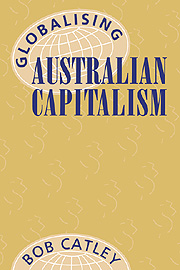Book contents
- Frontmatter
- Contents
- List of Tables
- List of Figures
- Preface and Acknowledgements
- List of Abbreviations
- Introduction
- 1 The International System and the End of the Cold War
- 2 The World Market and the Industrial Revolution in Asia
- 3 The Australian State and Economic Development
- 4 Economic Rationalism Changes Australian Politics
- 5 Government and Business in Australia
- 6 The Public Sector Reinvented
- 7 Australian Industry Restructures
- 8 Geographic Dimensions of Change
- 9 Australia Joins the Asia-Pacific Region: from ANZUS to APEC
- 10 All in a Day's Work
- Notes
- Index
9 - Australia Joins the Asia-Pacific Region: from ANZUS to APEC
Published online by Cambridge University Press: 14 January 2010
- Frontmatter
- Contents
- List of Tables
- List of Figures
- Preface and Acknowledgements
- List of Abbreviations
- Introduction
- 1 The International System and the End of the Cold War
- 2 The World Market and the Industrial Revolution in Asia
- 3 The Australian State and Economic Development
- 4 Economic Rationalism Changes Australian Politics
- 5 Government and Business in Australia
- 6 The Public Sector Reinvented
- 7 Australian Industry Restructures
- 8 Geographic Dimensions of Change
- 9 Australia Joins the Asia-Pacific Region: from ANZUS to APEC
- 10 All in a Day's Work
- Notes
- Index
Summary
In 1945 Australia self-consciously considered itself a rich, British-derived, white Anglo-Celtic nation of 7.5 million people, on a sparsely populated continent located off the coast of poor, densely peopled Asia. Almost all its politicians, business leaders and opinion formers were Anglo-Celtic males. Its Aboriginal inhabitants had no place in its power structure and were not even counted in the census. Its six major cities held over 80 per cent of a population that had grown very slowly during the previous fifteen years of depression and war. It exported primary products to and imported manufactures and capital from its principal trading partner, Great Britain. Its cautious Labor government determined to industrialise the country to avoid again the impoverished fate of a primary-producing country during a world depression. To assist this process and for strategic reasons it commenced a program of white immigration, soon running at over 1 per cent of population.
Australia was also a victorious power and member of the British Empire, one of the supposed three Great Powers. It had just made its first serious venture into Asia – as a military presence pursuing the defeat of Japan. It represented the British Empire during the post-war occupation of that country. It had also been deeply scarred by the experience of a war fought on Australian soil for the first time since European conquest of the continent. These events served only to confirm for Australians the alien nature of the geographic region in which they found themselves as a European settler-democracy.
- Type
- Chapter
- Information
- Globalising Australian Capitalism , pp. 181 - 207Publisher: Cambridge University PressPrint publication year: 1996



